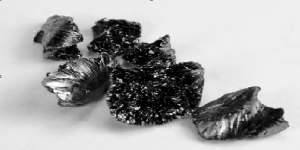In the last few years, two-dimensional crystals have emerged as some of the most exciting new materials to play with. Consequently, materials scientists have been falling over themselves to discover the extraordinary properties of graphene, boron nitride, molybdenum disulphide, and so on.
A late-comer to this group is black phosphorus, in which phosphorus atoms join together to form a two-dimensional puckered sheet. Last year, researchers built a field-effect transistor out of black phosphorus and showed that it performed remarkably well. This research suggested that black phosphorous could have a bright future in nanoelectronic devices.
 The big advantage of black phosphorus over graphene is that it has a natural bandgap that physicists can exploit to make electronic devices, such as transistors.
The big advantage of black phosphorus over graphene is that it has a natural bandgap that physicists can exploit to make electronic devices, such as transistors.
The research team reported a tunable band gap in BP, effectively modifying the semiconducting material into a unique state of matter with anisotropic dispersion. This research outcome potentially allows for great flexibility in the design and optimization of electronic and optoelectronic devices like solar panels and telecommunication lasers.
Read – New Human Genome Editing System Discovered
To truly understand the significance of the team’s findings, it’s instrumental to understand the nature of two-dimensional (2-D) materials, and for that one must go back to 2010 when the world of 2-D materials was dominated by a simple thin sheet of carbon, a layered form of carbon atoms constructed to resemble honeycomb, called graphene. Graphene was globally heralded as a wonder-material thanks to the work of two British scientists who won the Nobel Prize for Physics for their research on it.
Graphene is extremely thin and has remarkable attributes. It is stronger than steel yet many times lighter, more conductive than copper and more flexible than rubber. All these properties combined make it a tremendous conductor of heat and electricity. A defect-free layer is also impermeable to all atoms and molecules. This amalgamation makes it a terrifically attractive material to apply to scientific developments in a wide variety of fields, such as electronics, aerospace and sports. For all its dazzling promise there is however a disadvantage; graphene has no band gap.
Phosphorus is the fifteenth element in the periodic table and lends its name to an entire class of compounds. Indeed it could be considered an archetype of chemistry itself. Black phosphorus is the stable form of white phosphorus and gets its name from its distinctive color.
Read – Rare Earth Permanent Magnets in India
Like graphene, BP is a semiconductor and also cheap to mass produce. The one big difference between the two is BP’s natural band gap, allowing the material to switch its electrical current on and off. The research team tested on few layers of BP called phosphorene which is an allotrope of phosphorus.
Black phosphorus, named for its distinctive color, is a natural semiconductor with an energy bandgap that allows its electrical conductance to be switched “on and off.” It has been theorized that in contrast to graphene, black phosphorus has opposite anisotropy in thermal and electrical conductivities i.e., heat flows more easily along a direction in which electricity flows with more difficultly.
Such anisotropy would be a boost for designing energy-efficient transistors and thermoelectric devices, but experimental confirmation proved challenging because of sample preparation and measurement requirements.


